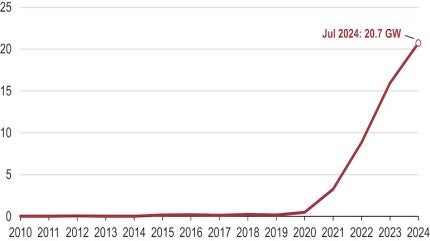
The total installed power of US utility-scale battery energy storage systems has been growing dramatically in recent years, according to data and analysis from the US Energy Information Administration. In the first seven months of 2024, operators added 5 GW to the US grid, compared with 4 MW added in 2010.
As of July 2024, more than 20.7 GW of total battery power was available in the United States, the US EIA estimates.
Among the support services provided to the grid by batteries, the US EIA lists the following: balancing of supply and demand; arbitrage; and allowing electricity from renewable sources, such as wind and solar, to be stored until needed instead of being curtailed at times when they produce more electricity than is consumed.
Most US utility-scale battery energy storage systems use Li-ion batteries, the US EIA notes.
It also says that its data collection defines small-scale batteries as being less than 1 MW, with small-scale battery data reported separately from utility-scale battery systems.
The US market growth is of course not lost on battery makers. Responding to the US boom, Saft, a subsidiary of TotalEnergies, has, for example, commissioned a new line at its Jacksonville factory in Florida to produce lithium-ion battery containers. This investment enables Saft to address the burgeoning demand for energy storage projects by offering battery storage systems with domestic content, as required by the Inflation Reduction Act 2022.
“Currently, we are successful in serving the US market using battery containers produced by our global factories overseas. Now our strategy to expand Jacksonville’s capacity to reach more than 5 GWh in 2027 will enhance its capability to provide a faster response to serve US customers and reduce our environmental footprint. At the same time, this will also incrementally increase local content by building up our US-based supply chains,” said Hervé Amossé, Saft EVP for Energy Storage Systems. “Saft will reach the Inflation Reduction Act 2022 requirements with its 5.1 MWh containers by 2026”, he added.
According to Bloomberg the US is the second largest and most mature energy storage system market in the world (after China), with 2023 being a record year that saw 22 GWh of energy storage deployed. The US market is expected to reach a cumulative 134 GW and 484 GWh in 2030, suggests Bloomberg.
Since delivering its first US energy storage project, in Alaska in 2003, Saft has also delivered other major US projects such as the Myrtle and Danish Fields utility scale solar-power-with-storage facilities in Texas, each exceeding 200 MWh of storage.






